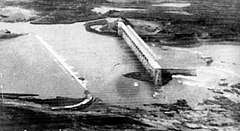1979 Machchhu dam failure
The Machchhu dam failure or Morbi disaster was a dam-related flood disaster which occurred on 11 August 1979, in India. The Machchu-2 dam, situated on the Machchhu river, burst, sending a wall of water through the town of Morbi (now in the Morbi district) of Gujarat, India.[2] Estimates of the number of people killed vary greatly ranging from 1800 to 25000 people.[1][3][4]
 Failed earthen embankment of Machchhu-2 dam | |
| Location | Morbi and villages of Rajkot district, Gujarat, India |
|---|---|
| Deaths | 1800-25000 (estimated)[1] |
| Property damage | Estimated ₹100 crore (equivalent to ₹21 billion or US$290 million in 2019)[2] |
The Machchu-2 dam
The first dam on Machchhu river named Machchhu-1 was built in 1959 having catchment area of 730 km2. The Machchhu-2 dam was constructed at downstream of Machchhu-1 in 1972 has a catchment area of 1929 km2.[5]
It was a earthfill dam. The dam was meant to serve an irrigation scheme. Considering the long history of drought in Saurashtra region, the primary purpose consideration at the time of design was the water storage, not the flood control. It consisted of a masonry spillway of 206 metres (676 ft) consisting 18 sluice gate in river section and earthen embankments on both sides. The spillway capacity provided for 5663 m³/s.[6] The embankments were of 2,345 metres (7,694 ft) and 1,399 metres (4,590 ft) of length on left and right side respectively.[7] The embankment had a 6.1 m top width, with slopes 1 V : 3 H and 1 V : 2 H respectively for the upstream and downstream slopes and a clay core extending through alluvium to the rocks below. The upstream face had a 61 cm small gravel and a 61 cm hand packed rip-rap. It had a storage capacity of 1.1 × 108 m3. The dam had a height of 22.56 m above the river bed, a 164.5 m of crest length of overflow section, and a total of 3742 m of crest length for the earth dam.
Failure
The failure was caused by excessive rain and massive flooding leading to the disintegration of the earthen walls of the four kilometre long Machchhu-2 dam. The actual observed flow following the intense rainfall reached 16307 m³/s, thrice what the dam was designed for, resulting in its collapse. The 762 metres (2,500 ft) of left and 365 metres (1,198 ft) of right embankment of dam were collapsed.[7] Within 20 minutes the floods of 12 to 30 ft (3.7 to 9.1 m) height inundated the low-lying areas of Morbi industrial town located 5 km below the dam.[6]
Around 3.30 pm the tremendous swirling flow of water stuck the Morbi. Water level rises to 30 feet (9.1 m) within next 15 minutes and some low lying areas of city were under 20 feet (6.1 m) of water for next 6 hours.[2]
The Morbi dam failure was listed as the worst dam burst in the Guinness Book of Records[8] (before the death toll of the 1975 Banquiao Dam failure was declassified in 2005).[9] The book No One Had A Tongue To Speak by Tom Wooten and Utpal Sandesara debunks the official claims that the dam failure was an act of God and points to structural and communication failures that led to and exacerbated the disaster.[10] There was great economic loss. The flood damaged the farmland, leading to a decrease in productivity of crops.
The book by Wooten and Sandesara gives a vivid first person account of many survivors. It narrates how people scrambled for rooftops, hilltops, and other safe grounds in order to save themselves. Over a hundred people took shelter in Vajepar Ram Mandir but later the deluge submerged them with the temple. Women were compelled to drop their babies into the furious surge in order to save themselves and people lost their loved ones in a flash.[11]
During reconstruction of the dam the capacity of the spillway was increased by four times and fixed at about 21,000 m³/s.[6]
Popular culture
The upcoming Gujarati disaster film Machchhu is based on the Machchu dam failure.[12]
References
- Noorani, A. G. (21 April 1984). "Dissolving Commissions of Inquiry". Economic and Political Weekly. 19 (16): 667–668. JSTOR 4373178.
- Noorani, A. G. (25 August 1979). "The Inundation of Morvi". Economic and Political Weekly. 14 (34): 1454. JSTOR 4367866.
- World Bank. Environment Dept (1991). Environmental assessment sourcebook. World Bank Publications. p. 86. ISBN 978-0-8213-1845-4.
- S.B. Easwaran (27 August 2012). "The Loudest Crash Of '79". Outlook India. Retrieved 6 March 2013.
- "Machchhu River". Narmada, Water Resources and Water Supply Department, Government of Gujarat. Retrieved 28 December 2017.
- Rao, Professor T. Shivaji. "Polavaram Dam Failure Kills 45 Lakhs of People". Retrieved 9 January 2012.
- Vijay, Nagendra (October 2008). "Safari Magazine, Issue 173". Scribd (in Gujarati). p. 15-23. Retrieved 3 August 2020.
- Guinness, El Libro de los Récords [Guinness Book the Records] (in Spanish). Mexico: Ediciones Maeva, S.A. October 1986. ISBN 978-968-458-366-5.
- "People's Daily Online -- After 30 years, secrets, lessons of China's worst dams burst accident surface". Retrieved 26 April 2018.
- "Book on 1979 Morbi dam disaster rubbishes 'Act of God' theory". The Indian Express. 25 July 2012.
- "Machhu dam disaster of 1979 in Gujarat – Discussion on a book by Tom Wooten and Utpal Sandesara".
- "Machchhu: A real life tragic story is all set to release - Times of India". The Times of India. Retrieved 19 April 2020.